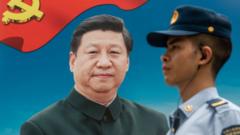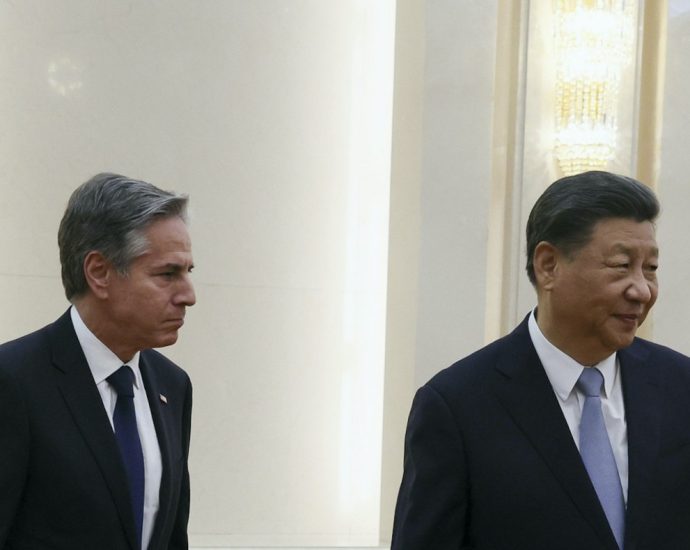Xi Jinping replaces leaders of China’s elite nuclear force
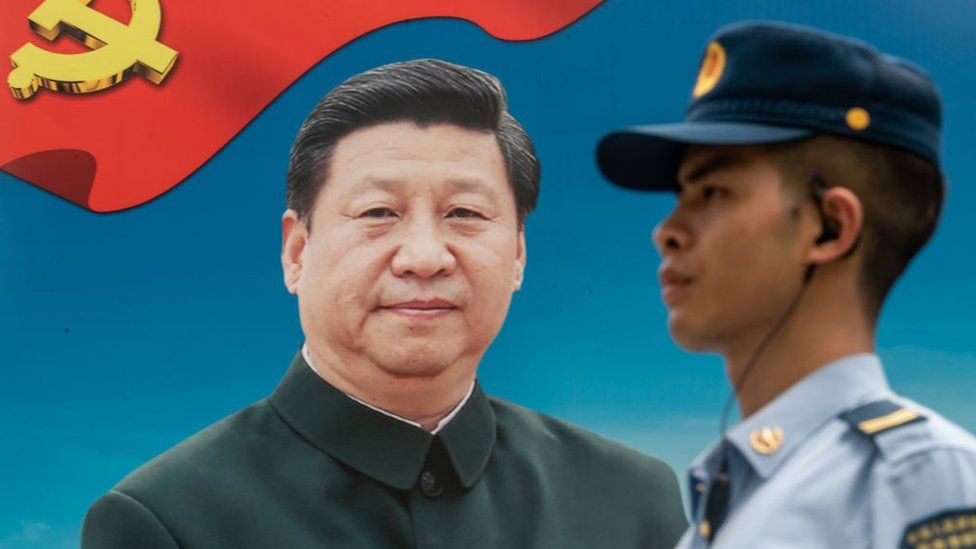 Getty Images
Getty ImagesChina replaced two leaders of an elite unit managing its nuclear arsenal, triggering speculation of a purge.
General Li Yuchao who headed the People’s Liberation Army ‘s (PLA) Rocket Force unit and his deputy had “disappeared” for months.
Former deputy navy chief Wang Houbin and party central committee member Xu Xisheng were named as replacements.
This is the biggest irregular shake-up in Beijing’s military leadership in almost a decade.
“The latest purge is significant… [as] China is undertaking one of the most profound changes in nuclear strategy in decades,” said Lyle Morris, a foreign policy and national security fellow at the Asia Society Policy Institute.
“Xi has consolidated control of the PLA in unprecedented ways, but that doesn’t mean it’s complete. Xi is still worried about corruption in the ranks and has signalled that absolute loyalty to the [party] has not yet been achieved,” he said.
Mr Xi is also chairman of China’s top military command, the Central Military Commission.
At a meeting late last month, Mr Xi stressed the need to focus efforts on “addressing prominent issues faced by party organisations at all levels, in aspects such as maintaining the party’s absolute leadership over the military”, Chinese state media reported.
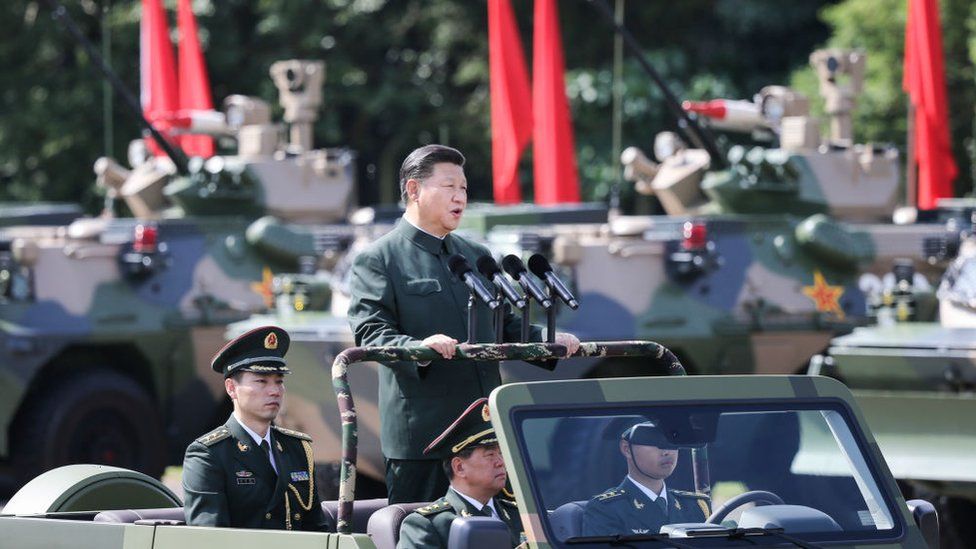
Beijing has not commented on the whereabouts of Gen Li and his deputy General Liu Guangbin, but a South China Morning Post report last week suggested that the commission’s anti-corruption arm had launched a probe into the two men, as well as Gen Li’s former deputy Zhang Zhenzhong.
The report cited two unnamed sources.
Mr Wang’s and Mr Xu’s new appointments came a day before the 96th anniversary of the PLA’s founding on 1 August. They were announced at a ceremony at the commission’s headquarters in Beijing.
Both have been promoted from the rank of lieutenant general to full general which in China marks the highest rank for active service officers.
Mr Morris said Gen Li’s downfall, together with the recent replacement of former foreign minister Qin Gang, presents one of the biggest leadership challenges for Mr Xi in recent times.
Mr Qin had been absent from public commitments for a month before he was replaced, unexplained, by his predecessor Wang Yi last week.
In 2014, a broad purge among China’s military ranks saw former deputy chairs of the Central Military Commission Xu Caihou and Guo Boxiong ousted and prosecuted for corruption. Guo was sentenced to life in jail by a military court, while Xu died before his trial.
Related Topics
-
-
5 days ago
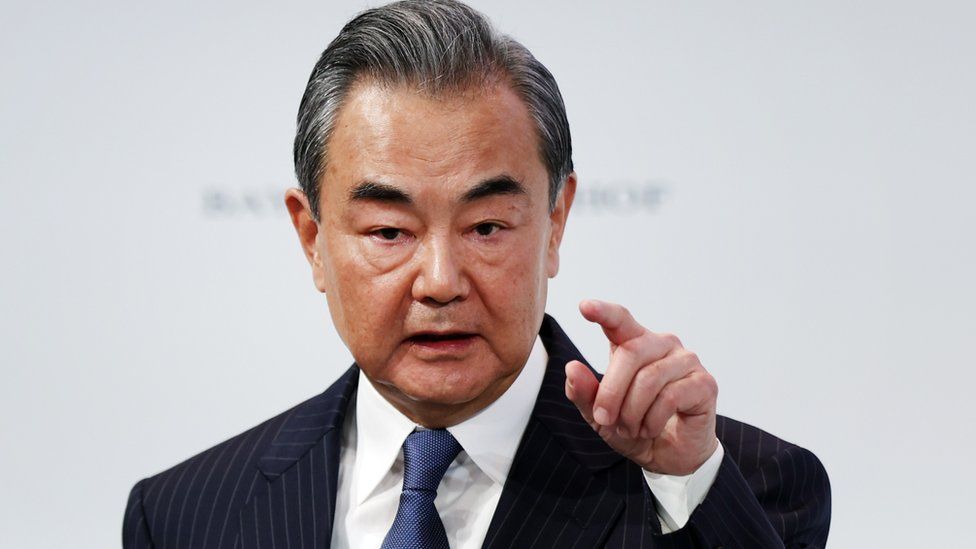
-
âThe Kerala Storyâ and religious-sexual politics
A controversial low-budget Indian feature film “The Kerala Story”, about a discredited anti-Muslim conspiracy theory, has been causing a political storm, going all the way to India’s Supreme Court.
The movie has helped circulate the idea of “love jihad,” a right-wing conspiracy theory that Muslim men are predators and out to marry and steal Hindu women. These ideas date back to the British colonial era and have far-reaching implications for people’s everyday lives.
The trailer claimed 32,000 Hindu girls had been converted to Islam by Muslim men with the intent of recruiting them to ISIS.
Once the film came out, citizens tried to get it banned by sending a petition to the India’s Supreme Court.
“Love jihad” is a conspiracy theory that claims Muslim men are converting Hindu and Christian women to Islam. Allegedly, the men feign love, get the women pregnant and eventually traffic them. The motive? To increase the Muslim population of India, perpetuate fanaticism and ultimately establish an Islamic state.
According to a recent Pew Report, shared-faith couples account for 99 per cent of married couples in India. Muslims account for approximately 14 per cent of India’s population.
There is no such thing as a “love jihad” and an investigation by India’s National Investigation Agency has said there is no evidence of “love jihad” taking place.
Political fallout
The figure of 32,000 women in the film’s trailer was immediately challenged by Indian political leaders and also debunked by fact-checkers from the website, Alt News.
The filmmakers agreed to change the number and a new trailer was released. It removed and replaced “32,000 girls” with “the true stories of three girls.”
And the movie went forward with its release, which according to some news reports, was successful at the box office.

Challenges in the Indian Supreme Court
Some politicians decried the propagandist nature of the movie and in West Bengal, it was banned by the government. Politicians there said the film “manipulated facts and contains hate speech in multiple scenes” and they banned the film to “avoid violence and hatred.”
The Indian Supreme Court lifted the state ban although it agreed that a disclaimer on the film was necessary. The disclaimer indicated that the film provides “no authentic data” to support the 32,000 figure and that it presents fictionalized accounts.
Other politicians, including some from the ruling Bharatiya Janata Party, promoted the film. Some of them even offered complimentary tickets or organized free screenings.
Prime Minister Narendra Modi endorsed the movie, assigning to it a distinct legitimacy.
Islamophobia from the 19th century
The idea of “love jihad” is both current and historical with notions coming from Indian and Hindu nationalism as well as 19th-century British colonial narratives. Both streams constructed Muslim men as hypersexual and hyperaggressive.
In the 19th century, Hindu scholars and new religious organisations (like Arya Samaj and Hindu Mahasabha) began producing a new Hindu-centric version of Indian history. This history grew in response to British colonialism but at the same time, shared similarities with British colonial ideas.
The British portrayed themselves as just rulers, partly by contrasting themselves with their casting of Muslim kings as hypersexual fanatics.
They pointed to a medieval darkness marked by the lust and tyranny of Muslim rulers. Mughal rulers were portrayed as rapists attacking both Hindu women and “Mother India.” This portrayal included the Muslim Prophet Muhammad who was portrayed in some places as sexually perverse.
These ideas became part of the curriculum in certain Indian states and elite Hindu scholars, educated at colonial schools, perpetuated these narratives in their writing. And the idea of a type of “love jihad” became part of the discourse created through pamphlets, novels, newspapers and magazines — especially in North India.
By the late 19th century, India was constructed around Hindu heterosexual relationships and family values in opposition to purported Muslim sexual deviance and rampant sexuality.
In 1923, Madan Mohan Malaviya, the president of the Hindu Mahasabha, said in a speech, “hardly any day passes without our noticing a case or two of kidnapping of Hindu women and children by not only Muslim badmashes (rogues) and goondas (hooligans), but also men of standing and means.”
Challenges to interfaith marriage
Today, it’s not just The Kerala Story that has circulated the “love jihad” myth. Reportage in Hindu nationalist media continues to make headlines.
Organizer, a magazine run by the Rashtriya Swayamsevak Sangh (RSS), a network of Hindu nationalist organizations, recently claimed that three cases of love jihad following the same pattern as those in ‘The Kerala Story’ were reported in a month.
Love jihad’s centrality to Hindu nationalist politics has led to specifically stringent laws focused heavily on sexuality and marriage.
Hindu vigilantes, in partnership with the police, launch missions to separate interfaith couples. Muslim men have been brutalized, killed, forced into hiding and incarcerated using historic anti-conversion laws.
One response to the chatter about “love jihad,” is an Instagram channel called India Love Project launched to celebrate stories of interfaith love and marriages.

Hopefully, such efforts continue to address Islamophobia and broaden to include a larger public discourse looking at transnational Islamophobic interlinkages, both past and present.
Wajiha Mehdi is a PhD Candidate at the Institute for Gender, Race, Sexuality and Social Justice, University of British Columbia.
This article is republished from The Conversation under a Creative Commons license. Read the original article.
The âmost difficult partyâ to get into? China toughens Communist Party entry
In Xi’s keynote speech to the party’s disciplinary apparatus in January, he told anti-corruption watchdogs to “strengthen the education, management and supervision of young cadres” and ensure they “fasten the first button in their political career right”. Xie said the Communist Party was “in no hurry” to cross the 100Continue Reading
More Bakhmut fighting may see war end â or expand
No matter what pronunciamentos may come from Washington, the Russian government is expecting greater attacks on Russian territory – especially Moscow and maybe Russian ports – to try and destabilize the Putin government.
The Pentagon says that no US weapons will be used against Russian territory, but this is an outright lie. US drones and cruise missiles such as Himars plus cluster munitions supplied by the United States are used daily by Ukraine, targeting Russian territory.
So, too, is the British-French Storm Shadow (SCALP-EG). Both the British and French heavy precision cruise missiles are made by MBDA (a Consortium of French, British and Italian companies).
Nor can the US properly explain what a Global Hawk is doing spying on Russian territory, presumably to help Ukraine target Russian assets, both military and civilian.
The US openly admits that it planned and supplied Ukraine with the semi-submersible kamikaze drones used against the Kerch Strait bridge which connects Crimea to Russia, making it an attack on Russia.
Such operations are not lost on Moscow, which openly believes that it is at war with NATO led by the United States.
Thus, no matter what is said by the Pentagon or by Washington more broadly, the Biden administration is skirting close to the edge of a wider war in Europe.
The chance for a settlement of the war in Ukraine is not only elusive but increasingly irrelevant if Washington’s war aims are what they appear to be.
On August 5 and 6, Saudi Arabia is hosting a so-called peace conference on Ukraine. Some 30 nations will attend, apparently including Iran. But Russia was not invited. That suggests that the peace conference is a propaganda show, not serious.
Sooner or later, probably sooner, Russia either will decide that the war in Ukraine is a fruitless pursuit and give it up or it will decide to go after the war’s backers and suppliers.
If Russia walks away, the Russian government will fall. If Russia stays in it, the hard line nationalist faction will gain a big victory and demand that Russia expand the war. At that point, Putin will have to either reformulate his government to reflect the changes or decide not to stand for election in 2024.
If Putin steps down, there are a number of candidates to replace him from the security services and from the military. The most likely winners would come from the hard nationalist right, not from the enfeebled left.
No one can say with any certainty how resilient Russia’s military is. In the current Ukraine fighting, both sides appear to be locked in continuous battles along in the Donbas and the southern Zaphorize areas. Judging from physical evidence, the Ukrainians have lost a lot of equipment and manpower. Russian Defense Minister Shoighu claims that Ukraine lost 20,000 soldiers in July.
Russian losses are far harder to judge. If Russia stays in the war, the question arises how long it will take to wear down the Ukrainians, who face manpower shortages.
From a warfront perspective it appears that Ukraine, helped directly by the United States and the UK, is hoping to make some breakthroughs and break open Russia’s first defensive line in the south, while also hoping to control the flanks around Bakhmut and – if Zelensky wins – take back Bakhmut.
Just this past week Zelensky showed up in Chasiv Yar, the first time he has been there since before Bakhmut fell. Zelensky believes, thanks to the help he is getting from the US and UK, and from freshly trained high quality brigades, that he may be able to turn the trick.

What happens in Bakhmut could spell the end of the Ukraine war, with either a Ukrainian victory or a Russian win.
If Russia wins, Ukraine may have to accept Russian terms for a settlement. If Ukraine wins, Russia will be forced to pull some of its forces out of eastern Ukraine and could also face the loss of critical areas in the south, even Crimea.
Russia also has the option, a dangerous one, to expand the war outside of Ukrainian territory, for example in Poland or the Baltic States. Putin has made it clear that he does not favor any war expansion – but does Putin have enough clout left in Russia as outside pressure on the regime ramps up, and as internal unhappiness with the war could tilt to a more aggressive Russia?
In the annual Navy Day extravaganza hosted in St Petersburg, Putin in his address made no mention of the Ukraine war even though Navy Day came the day after drones hit Moscow. Is Moscow in denial? In the parade of ships and submarines this year, no Russian nuclear submarines were on display: nor did Russian naval aviation appear as it had during previous Navy Day exercises.
What is clear is that the war cannot stay undecided for much longer. The US and NATO are gambling on regime change in Russia, but they may get exactly what they do not want.
Regime change in Russia could be a bitter pill for NATO.
Russia is gambling on prevailing in Ukraine, but it is a hard fight and dragging on for too long.
Ukraine is hoping to punch through with some decisive wins and wants to throw the Russians out.
The betting table is open.
Stephen Bryen is a senior fellow at the Center for Security Policy and the Yorktown Institute. This article was originally published on Weapons and Strategy, his Substack. Asia Times is republishing it with permission.
Weaponization of US-China military communications Â

The main purpose of last month’s visit to China by US Secretary of State Antony Blinken was, in his words, to re-establish communications to reduce “ misunderstandings and miscommunications” so as to prevent or manage incidents between the two militaries. But he was unsuccessful. It seems that the very agreement to talk has become politicized and that the communications process is being “used” to the advantage of one or the other.
The level of US-China military communications is at a historic nadir and incidents between their militaries are increasing in frequency and intensity. As incidents proliferate, a cacophony of policymakers and analysts – including myself – is calling for better communication to avoid or manage them before they get out of control.
Tension remains high. On June 3, a collision between US and Chinese warships was narrowly avoided when a Chinese vessel abruptly cut across the bow of the US ship in the Taiwan Strait. This incident came hot on the heels of a May 31 incident that Washington called an unsafe and unprofessional intercept of a US intelligence-collection plane over the South China Sea.
Both blamed each other for the near catastrophes. According to the US, these incidents were part of a pattern of more aggressive and belligerent risk-taking.
The US wants to re-establish communications to buy time and tamp down the possibilities of conflict. But China is not “cooperating.” As Sun Yun, senior fellow and co-director of the East Asia Program and director of the China Program at the Stimson Center, points out, their positions on restarting military dialogue may be part of a strategy that encompasses the communication process.
At the very least it seems to have been captured by their fundamental differences. Some even say China is not interested in improving military-to-military communications and believes actions on both sides speak for themselves.
As Sun points out, with the US overreach in the Ukraine war and hotspots around the globe, China may think that Washington is more averse to conflict than it is. That means China thinks it has more diplomatic space to maneuver.
Suspicion on both sides
China may also think that agreeing to communicate will undermine its tactic of brinkmanship. Moreover, it may want to keep the US guessing and cautious as to its intent and red lines whose crossing may trigger military conflict.
China may also think that the process of military communication favors the US because it can point to it as its good-faith effort and have more freedom of action while negotiations continue.
At the extreme, China may even believe that a crisis would provide an opportunity to extract concessions from the US and to negotiate in earnest a regime of peaceful co-existence.
So China may want to slow-play military-to-military communications. If this is so, US personal sanctions on Defense Minister Li Shangfu provide it an opportunity to refuse dialogue and blame it on a petty ad hominen.
Realpolitik is influencing the talks. China is demanding that the US demonstrate good faith by actions, not words. It seems that every opportunity for meaningful talks is preceded, followed or even accompanied by aggressive or negative actions on both sides.
The close-in intelligence-gathering and freedom of navigation operations (FONOPs) continue unabated. The US mouths the “one-China policy” yet it sends ever more arms and high-level politicians to Taiwan.
We only know of major incidents. It seems that there are more that go unreported. China wants the US to dial back its daily close-in intelligence-gathering focused on its defenses as well as its provocative and redundant FONOPs targeting China’s maritime claims. The US thinks that to do to so unilaterally could be a sign of weakness.
‘One China,’ sort of
Most important, China wants the US to tamp down its political and military support for Taiwan. Beijing believes Washington is bit by bit undermining the Shanghai Communiqué in which the US acknowledged there is only one China. It is difficult to envisage productive dialogue until these conditions are met. Otherwise mutual suspicion will prevail.
Even with better military-to-military communications, the trust gap is unlikely to improve and dangerous incidents are still likely. This is because they do not stem from misunderstandings and miscommunications but are rooted in deeper differences regarding the “international order” and strategic interests. So the best outcome of talks would be to set up a system to manage these incidents when they occur.
The two countries have stated their fundamental policies regarding their relationship. Chinese President Xi Jinping proffered “three nos.” China “does not seek to change the existing international order, does not interfere in the United States’ internal affairs and has no intention of displacing the United States.”
US President Joe Biden has stated “five nos.”
“The United States does not seek a new cold war. It does not seek conflict with China to change China’s system. The revitalization of its alliances is not directed at China and does not support Taiwanese independence.”
But their actions do not seem to match their words.
Xi has proposed “a new model of great-power relations” that implies equality and shared responsibility in world affairs. But so far the US has in essence rejected it, apparently because it believes that it is the world’s only “exceptional” nation. Expecting that to change soon is unrealistic.
This communications conundrum is a corollary to the concept of mutual transparency in military affairs. While military “transparency” may sound neutral and reasonable, it favors the more powerful. The more powerful country can intimidate the other by revealing its capabilities while the inferior military power displays its weaknesses that can be exploited by the more powerful side.
Besides, “transparency” is ambiguous. The US claims to be transparent, but try to ask questions about the position and role of its nuclear-armed submarines, or its specific intelligence collection capabilities in the South China Sea.
Until the “nos” on either side begin to ring true, there will be little progress on meaningful military-to-military communications, and tension will remain high in the South China Sea.
An edited version of this piece appeared in the South China Morning Post.
Rock legends Sweet Charity reflect on illustrious career ahead of reunion concert

Rock band Sweet Charity isn’t just an icon of Malay music – they’re Singapore’s legacy in the music world. The band was formed in 1969 by vocalist Ramli Sarip, drummer Rahman Sarbani, guitarist Joe Salim and bassist Wahid Warren. Years later, guitarist Rosli Mohalim and organist Ahmad Jaffar (AJ) joined the crew and the rest is history.
More than 50 years later, their hit songs – such as Kamelia and Jangan Tunggu Lama-Lama (Don’t Wait Too Long) – are still being played regularly by fans in the region.
From “playing at weddings in Bedok” to selling out stadiums in Asia, Sweet Charity has undoubtedly left an indelible mark on rock fans everywhere.
After a 10-year hiatus, Sweet Charity will be reuniting for a concert, titled Ribut The Concert, on Oct 14 at The Star Theatre. CNA Lifestyle met up with Ramli, Rosli and AJ to find out what fans can expect at this concert and, more importantly, to discuss their long-lasting legacy.
Koh Tao reports record tourist arrivals
PUBLISHED : 1 Aug 2023 at 11:18

SURAT THANI: Koh Tao, in the Gulf of Thailand northwest of Koh Samui, reported a record number of tourist arrivals in one day on July 28, provincial governor Wichuwat Jinto said.
The tourist association of Koh Tao, a tambon in Koh Phangan district, reported that 3,106 tourists arrived on the island by boats on July 28, the start of the six-day government holiday that ends on Aug 2. This was a one-day record, he said.
The governor said about 90% of the tourists were foreigners who were likely to travel to Koh Phangan for the Full Moon Party at Hat Rin beach on Aug 3.
On nearby Koh Samui, the number of tourists passing through the island’s airport reached 141,454 in the month of July. In August, the number was expected to go up by 30,000 to 171,834, based on hotel reservations. In addition to air travellers, more were expected to arrive by ferry or speed boat.
Ratchaporn Poonsawat, president of the Tourism Association of Koh Samui, said there were now not enough flights to take all the tourists who made advance room reservations, resulting in cancellations.
Mr Ratchaporn said the association is asking airlines to increase the number of flights to about 50 a day during the high season, when about 5 billion baht is expected to be injected into the island’s economy.
OneAviation Careers fair returns with walk-in interviews for more than 1,700 jobs
SINGAPORE: The OneAviation Careers fair will return for a second edition this week, the Civil Aviation Authority of Singapore (CAAS) said on Tuesday (Aug 1), adding that walk-in interviews will be conducted to fill more than 1,700 vacancies. The event will take place from Aug 4 to Aug 5 atContinue Reading
Man charged with running unregistered Muslim religious school, teaching false doctrine
SINGAPORE: A man was charged in court on Tuesday (Aug 1) with running an unregistered Muslim religious school and teaching false doctrine for about 16 years. Mohd Razif Radi, 65, was handed one charge of teaching a doctrine in a manner contrary to Muslim law under the Administration of MuslimContinue Reading
Australian childcare worker charged with sex abuse of 91 children
 Getty Images
Getty ImagesA former Australian childcare worker has been charged with more than 1,600 offences after allegedly sexually abusing 91 children, filming it, then distributing it online.
Police alleged the man preyed on young girls over a 15-year period at a dozen centres in Australia and abroad.
He was arrested in August 2022, but it has taken police a year to investigate and identify alleged victims.
Authorities say it is one of the most “horrific” cases they have ever seen.
The 45-year-old man is facing 246 counts of rape and 673 counts of indecent assault against children – many of them in aggravated circumstances.
The charges carry a maximum sentence of life imprisonment.
He also faces hundreds of charges for filming and distributing child abuse material. Police allege he recorded all of his abuse, and say they found 4000 images and videos on his electronic devices.
The offending allegedly occurred in 10 childcare centres in Queensland, and one each in New South Wales and an unnamed overseas country. The man worked at other childcare centres, but the AFP says it is “highly confident” he did not offend at those centres.
Speaking to media on Tuesday, Australian Federal Police Commissioner Justine Gough said the case would be “deeply distressing” for the community.
“It’s beyond the realms of anyone’s imagination, what this person did to these children. You try not to be shocked after a long period of time in the police… but this is a horrific case,” she said.
The 87 Australian children who were allegedly abused – some of whom are now adults – have been identified and their families contacted.
Australian authorities are now working with their international counterparts to contact the other four alleged victims.
Investigators say they caught the man after they were able to identify the background appearing in child abuse material as one of the childcare centres he worked at.
The AFP executed a search warrant at the Brisbane centre on 20 August 2022, before also searching the man’s Gold Coast home and seizing electronic devices allegedly containing child abuse material he had created.
He had been reported to police in Queensland twice before, in 2021 and 2022, but investigators had found insufficient evidence to act, police say.
The man – who is yet to be named – is next due to appear in Brisbane Magistrates Court on 21 August.

